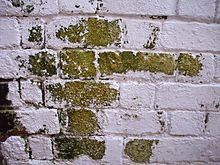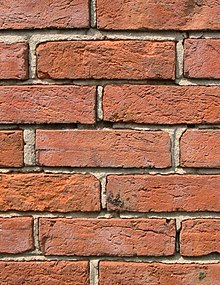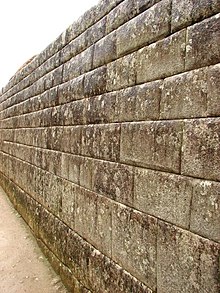Wall: Difference between revisions
No edit summary |
|||
| Line 85: | Line 85: | ||
A wall can also refer to something that the human mind is blocking or hiding from memory but this is debatable. |
A wall can also refer to something that the human mind is blocking or hiding from memory but this is debatable. |
||
==Spartan wall== |
|||
LIKAAAAAA WALL YO~ |
|||
An unbreakable wall that never faulter |
|||
==See also== |
==See also== |
||
* [[List of walls]] |
* [[List of walls]] |
||
Revision as of 15:18, 25 November 2011

A wall is a usually solid structure that defines and sometimes protects an area. Most commonly, a wall delineates a building and supports its superstructure, separates space in buildings into rooms, or protects or delineates a space in the open air. There are three principal types of structural walls: building walls, exterior boundary walls, and retaining walls.


Building walls have one main purpose: to support roofs and ceilings. Such walls most often have three or more separate components. In today's construction, a building wall will usually have the structural elements (such as 2×4 studs in a house wall), insulation, and finish elements or surface (such as drywall or panelling). In addition, the wall may house various types of electrical wiring or plumbing. Electrical outlets are usually mounted in walls.
Building walls frequently become works of art externally and internally, such as when featuring mosaic work or when murals are painted on them; or as design foci when they exhibit textures or painted finishes for effect.
On a ship, the walls separating compartments are termed "bulkheads", whilst the thinner walls separating cabins are termed "partitions".
In architecture and civil engineering, the term curtain wall refers to the facade of a building which is not load-bearing but functions as decoration, finish, front, face, or history preservation.
Partition wall
A partition wall is a wall for the purpose of separating rooms, or dividing a room. Partition walls are usually not load-be
Partition walls may be constructed with bricks or blocks from clay, terra-cotta or concrete, reinforced, or hollow. Glass blocks may also be used.
They may also be constructed from sheet glass. Glass partition walls are a series of individual toughened glass panels, which are suspended from or slide along a robust aluminium ceiling track. The system does not require the use of a floor guide, which allows easy operation and an uninterrupted threshold.
Timber may be used. This type of partition consists of a wooden framework either supported on the floor below or by side walls. Metal lath and plaster, properly laid, forms a reinforced partition wall. Partition walls constructed from fibre cement sheeting are popular as bases for tiling in kitchens or in wet areas like bathrooms. Galvanized sheet fixed to wooden or steel members are mostly adopted in works of temporary character. Plain or reinforced partition walls may also be constructed from concrete, including pre-cast concrete blocks.
Metal framed partitioning is also available. This partition consists of track (used primarily at the base and head of the partition) and stud (vertical sections fixed at 600mm centres).
Internal wall partitions also known as office partitioning is made using plasterboard (drywall), or varieties of glass. Toughened glass is a common option as it is feasible however there is also low iron glass better known as opti-white glass which increases light and solar heat transmission.
Wall partitions are constructed using beads and tracking which are either hung from the ceiling or fixed into the ground. The panels are inserted into the tracking and fixed.
There are variations of wall partitions which include the level of fire resistance they have, and their acoustic performance rating.
Movable Partitions
Movable partitions are used where the walls of a room are frequently opened to form one large floor area. In this system, there are several types of partitions:
- Sliding: Sliding partitions consists of series of panels that slide in tracks fixed to the floor and ceiling. The machine if the partition is similar to those of sliding doors.
- Sliding & folding: Sliding and folding partitions operate in a similar manner to sliding folding doors. They are normally used for smaller spans.
- Screens: Screens are usually constructed of a metal or timber frame. It is fixed with plywood and chipboard inside. The screen supported with legs for free standing and easy movement.
- Pipe and drape: Fixed or telescopic uprights and horizontals provide a ground supported drape system with removable panels.
Boundary walls

Boundary walls include privacy walls, boundary-marking walls on property, and town walls. These intergrade into fences; the conventional differentiation is that a fence is of minimal thickness and often is open in nature, while a wall is usually more than a nominal thickness and is completely closed, or opaque. More to the point, if an exterior structure is made of wood or wire, it is generally referred to as a fence, while if it is made of masonry, it is considered a wall. A common term for both is barrier, convenient if it is partly a wall and partly a fence, for example the Berlin Wall. Another kind of wall/fence ambiguity is the ha-ha which is set below ground level, so as not to interrupt a view yet acting as a barrier to cattle for example.

Before the invention of artillery, many of the world's cities and towns, particularly in Europe and Asia, had protective walls (also called town walls or city walls). In fact, the English word "wall" is derived from Latin vallum, which was a type of fortification wall. Since they are no longer relevant for defense, such cities have grown beyond their walls, and many of the walls, or portions thereof, have been torn down, for example in Rome, Italy and in Beijing, China. Examples of protective walls on a much larger scale include the Great Wall of China and Hadrian's Wall.
Separation walls
Some walls are designed to formally separate one population from another. An example was the Berlin Wall, which divided East and West Berlin.
Retaining walls



In areas of rocky soils around the world, farmers have often pulled large quantities of stone out of their fields to make farming easier and have stacked those stones to make walls that either mark the field boundary, or the property boundary, or both.
Retaining walls are a special type of wall, that may be either external to a building or part of a building, that serves to provide a barrier to the movement of earth, stone or water. The ground surface or water on one side of a retaining wall will be noticeably higher than on the other side. A dike is one type of retaining wall, as is a levee, a load-bearing foundation wall, and a sea wall.
Shared walls
Special laws often govern walls shared by neighbouring properties. Typically, one neighbour cannot alter the common wall if it is likely to affect the building or property on the other side. A wall may also separate apartment or hotel rooms from each other. Each wall has two sides and breaking a wall on one side will break the wall on the other side.
Portable walls
Portable walls, such as room dividers or portable partitions, are used to take a large open space and effectively divide it into smaller rooms. Portable walls can be static such as cubicle walls, or they can be wall panels mounted on casters to provide an easy way to reconfigure assembly space. They are often found inside schools, churches, convention centers, hotels and corporate facilities.
Etymology
It is notable that English uses the same word to refer to an external wall, and the internal sides of a room. This is by no means universal, and many languages distinguish between the two. In German, some of this distinction can be seen between Wand and Mauer, in Spanish between pared and muro.
Walls in popular culture
Walls are often seen in popular culture representing barriers preventing progress or entry. For example, the progressive/psychedelic rock band Pink Floyd used a metaphorical wall to represent the isolation felt by the protagonist of their 1979 concept album The Wall. American poet laureate Robert Frost describes a pointless rock wall as a metaphor for the myopia of the culture-bound in his poem Mending Wall. In a real-life example, the Berlin Wall, constructed by the Soviet Union to divide Berlin into NATO and Warsaw Pact zones of occupation, became a worldwide symbol of oppression and isolation.
In some cases, a wall may refer to an individual's debilitating mental or physical condition, seen as an impassable barrier.
Another common usage is as a communal surface to write upon. For instance the social networking site Facebook uses an electronic "wall" to log the scrawls of friends.
Physiological wall
In marathon running a runner can 'hit' 'the wall'. A point where the human brain and body feels like it cannot be pushed further or continue. Runners find this incredibly hard to break through and continue.
A wall can also refer to something that the human mind is blocking or hiding from memory but this is debatable.
Spartan wall
LIKAAAAAA WALL YO~ An unbreakable wall that never faulter
See also
- List of walls
- Ashlar
- Curtain wall
- Dry-stone wall
- Fence
- Load-bearing wall
- Sleeper wall
- Stone wall
- Wallpaper
External links
![]() The dictionary definition of wall at Wiktionary
The dictionary definition of wall at Wiktionary
![]() Media related to Walls at Wikimedia Commons
Media related to Walls at Wikimedia Commons
